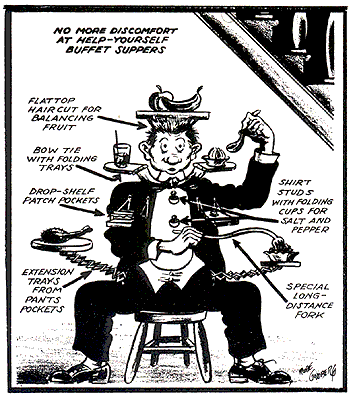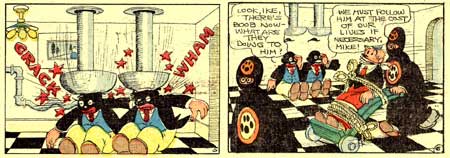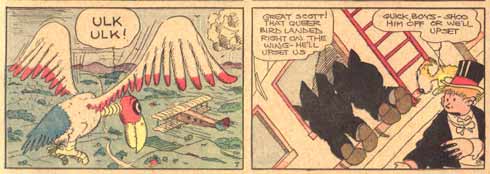Cartoon by Rube Goldberg, 1944.
Reuben Lucius Goldberg studied at the University of California at Berkeley. After graduating in 1904, he started out working as an engineer, designing sewers for the city of San Francisco. Six months later, he started working as a sports cartoonist for the San Francisco Chronicle. In 1907 he moved to New York after selling his Sunday half-page strip 'Mike and Ike'. This comic didn't generate much response. With a lot of effort, Rube Goldberg eventually landed a job at the New York Evening Mail, where he created the 'Foolish Questions' panel. Apart from drawing comics, he also took a shot at vaudeville, becoming a stand-up comedian and fortune teller in 1911.
Between 1907 and 1915, Rube Goldberg's large output included 'The Candy Kid', 'Lunatics I have Met', 'Soup and Fish', 'I'm the Guy', 'They All Look Good When You're Far Away' and 'The Weekly Meeting of the Tuesday Ladies' Club'. Goldberg's sports cartoons kept growing in popularity, and in 1915 he was assigned by to create a Sunday strip which was called 'Boob McNutt'. After that he re-launched his 'Mike and Ike' characters, this time with success. 'Boob McNutt', a helpless clown, was syndicated by McNaught until 1934.
'Boob McNutt', 1930.
In addition, Goldberg launched new strips for the Hearst papers, such as 'Phoney Films', 'Boobs Abroad' and 'Life's Little Jokes'. 'The Inventions of Professor Lucifer Gorgonzola Butts' resulted from Goldberg's engineering background, and was the artist's one-man war against modern gadgetry. His many creations of intricate and absurd inventions were hilarious and a "Rube Goldberg" contraption became part of American popular vocabulary. A predecessor to Goldberg's fictional inventions was Frank Crane's 'Willie Westinghouse' (1900-1907, 1908-1914). In 1928, Goldberg started his first (and probably best) daily strip, 'Bobo Baxter', which ran until 1930. In 1934 he created 'Doc Wright', about a doctor and his patients. In 1936 'Lala Palooza' was launched, but was not successful - and it ended in 1939.
'Boob McNutt', 1931.
Rube Goldberg was at his best and wackiest when he made his miscellany pages, such as 'Rube Goldberg's Sideshow', his last strip effort in 1939. He then focused on his editorial cartoons, which won him a Pulitzer Prize. He was additionally an essayist, poet, and playwright. In 1945 he co-founded the National Cartoonists' Society, becoming its first president. In 1954 the prestigious "Reuben Awards" (originally named the Billy DeBeck Awards, after Billy DeBeck) were named after him. At the age of 80, Goldberg embarked on a new career as a sculptor. Rube Goldberg died in 1970. Two of his assistants were John Devlin and Warren King.
Rube Goldberg was an influence on Al Capp, Al Jaffee, Harvey Kurtzman, William Heath Robinson and Basil Wolverton. The design of Bertha the dog in 'Boob McNutt' inspired Hergé to Tintin's faithful dog Milou (Snowy). Goldberg's comic series 'Foolish Questions' influenced 'Those Ridiculous Questions' by Raymond Crawford Ewer.Two celebrity fans of Goldberg were French painter Francis Picabia and film director Orson Welles.
In 2015, the city of San Francisco designated the 1911 building with Rube Goldberg's house, 182-198 Gough Street, a historical and cultural landmark, the "R.L. Goldberg Building". Although Goldberg lived in New York City for most of his professional life, he made extended visits to his San Francisco home.
Comic panel by Rube Goldberg.





